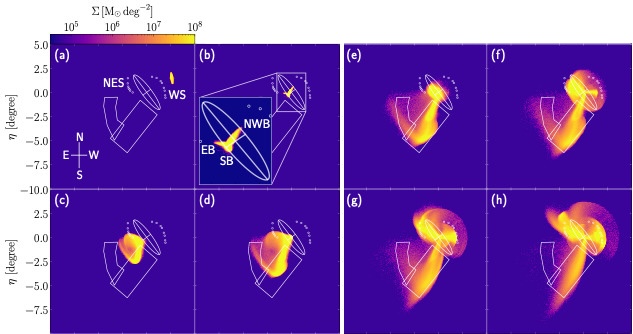Featured Articles
Simultaneous Formation of the Andromeda Giant Southern Stream and the Substructures in the Andromeda Halo
Misa Yamaguchi (University of Tsukuba, Graduate School of Science and Technology)
Masao Mori (University of Tsukuba, CCS)
Takanobu Kirihara (Kitami Institute of Technology)
Yohei Miki (University of Tokyo, Information Technology Center)
Itsuki Ogami (SOKENDAI / NAOJ)
Masashi Chiba (Tohoku University)
Yutaka Komiyama (Hosei University)
Mikito Tanaka (Hosei University)

The Cold Dark Matter (CDM) model, the current standard model of structure formation, suggests that larger galaxies formed hierarchically through the collisions and mergers of dwarf galaxies. Theory predicts that during this process, diffuse, faint structures consisting of stars, known as stellar streams (elongated stellar populations), emerge in the halo of host galaxies. Recently, the existence of many such streams has indeed been confirmed observationally.
In this study, we investigated a minor merger event between M31 (the Andromeda Galaxy) and a dwarf galaxy that could simultaneously form four identified substructures in M31: the Andromeda Giant Southern Stream (AGSS), the Eastern Extent (EE), the North-Eastern Shell (NES), and the Western Shell (WS). We discovered that the spatial features of these substructures can be reproduced by varying the scale radius and mass of the colliding dwarf galaxy's dark matter halo within the range predicted by the CDM model. We thus succeeded in constructing a unified formation model for these structures.
Specifically, within the limited parameter range considered in this study, we found that the evolution of the spatial distribution of the NES and WS does not depend on the gravitational potential of the dwarf galaxy's associated dark matter halo, although a shallower potential causes the formation location of the EE to shift northward. Furthermore, the simulation results revealed that the dwarf galaxy had a dark matter halo mass of $9 \times 10^{9} M_\odot$ and collided with M31 approximately 85 million years ago, simultaneously forming the four aforementioned substructures.
Additionally, although the EE and Stream Cp (the metal-poor component of Stream C, another M31 substructure) appear to overlap on the sky along our line of sight, our results suggest that along the line of sight, the EE is located several tens of kiloparsecs (kpc) closer to us than Stream Cp. Furthermore, we predict the existence of a "positive stream" along the AGSS, exhibiting a positive line-of-sight velocity relative to M31, which would be complementary to the already observed "negative stream" with its negative line-of-sight velocity.
Finally, we propose that three substructures — Stream B (another M31 substructure), the metal-rich component of Stream C known as Stream Cr, and the EE — are constituent components of the Andromeda Giant Southern Arc (AGSA), a vast stellar structure connected to the AGSS. The existence of the positive stream and the full extent of the AGSA have not yet been observationally confirmed, but it is expected that their existence will be verified through future spectroscopic observations and further advancements in theoretical research.
The figure shows the time evolution of the stellar particle surface mass density distribution of the dwarf galaxy on celestial coordinates. It illustrates how the bulge and disk of the dwarf galaxy are tidally disrupted following a central collision with M31 (the Andromeda Galaxy). Each panel indicates the elapsed time since the start of the simulation, corresponding to (a) 0.00 Gyr, (b) 0.20 Gyr, (c) 0.30 Gyr, (d) 0.40 Gyr, (e) 0.55 Gyr, (f) 0.70 Gyr, (g) 0.85 Gyr (corresponding to the present time), and (h) 1.05 Gyr. The white ellipse represents the disk of M31. The arc-shaped region enclosed by the white line, located southeast of the M31 center (the intersection of the ellipse's major and minor axes), is defined based on the stellar number map from Preston et al. (2021) and is shown for comparison with the simulated EE [likely Eastern Extent]. The rectangular region indicates the observed area of the AGSS (Andromeda Giant Stellar Stream) as defined by Conn et al. (2016). Furthermore, the white circles drawn to the east and west of the M31 center show the respective positions of the observed North-Eastern Shell (NES) and Western Shell (WS) (Fardal et al. 2007). The orientation is displayed in the lower left of panel (a). Panel (b) indicates the Eastern Branch (EB), Southern Branch (SB), and North-Western Branch (NWB).


 和 英
和 英